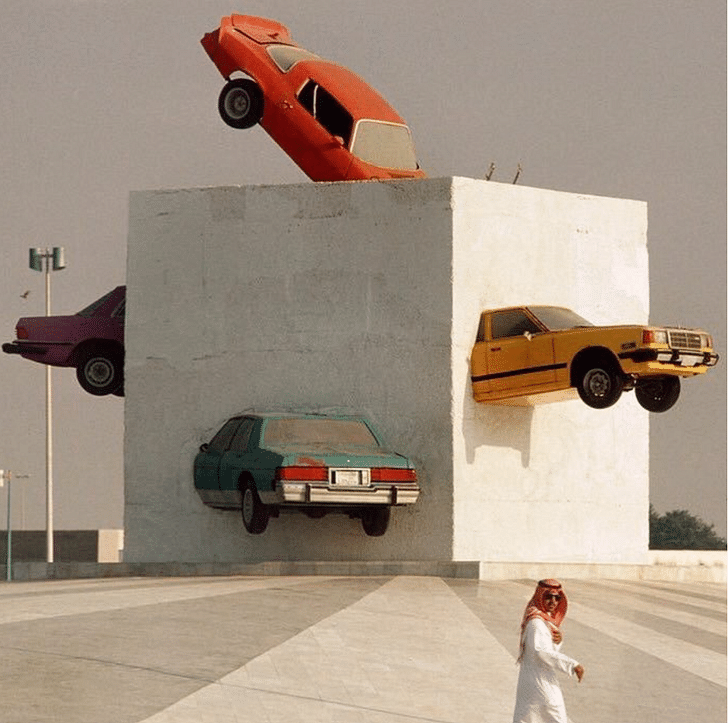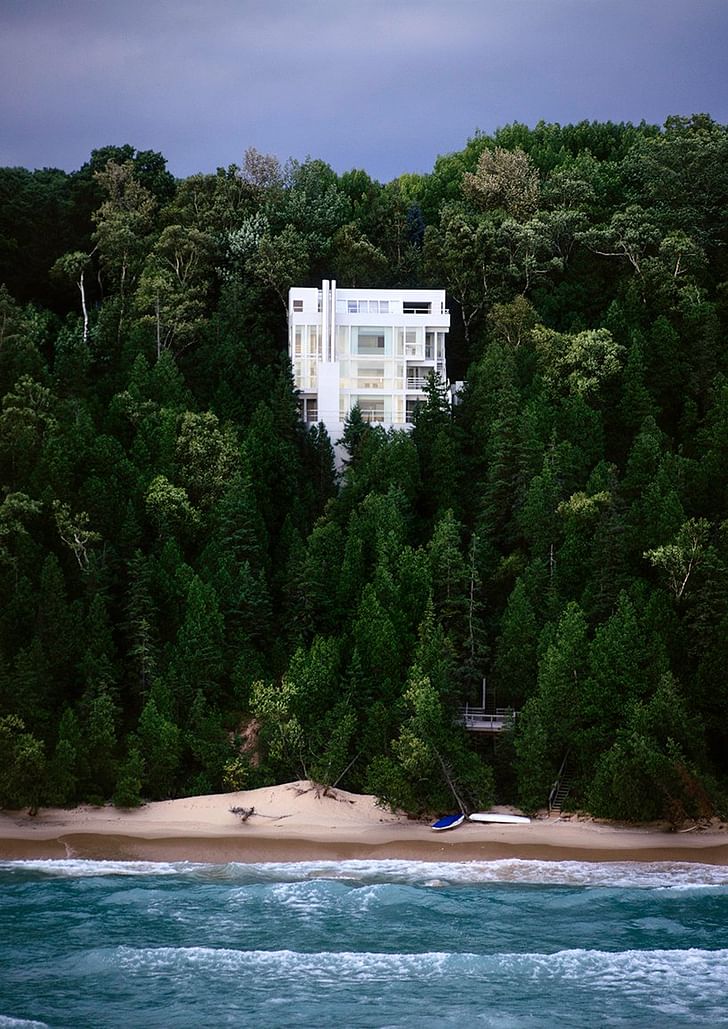

#ArchinectMeets is a series of interviews with members of the architecture community that use Instagram as a creative medium. With the series, we ask some of Instagram’s architectural photographers, producers and curators about their relationship to the social media platform and how it has affected their practice.
Social media has undeniably affected the way we perceive, interpret and share opinions about architecture today. While we use our own account, @Archinect, as a site for image curation and news content, we wanted to ask fellow Instagram users how they navigated the platform.
We spoke to Kate Sennert, curator of @newagecocaine. The photographs she finds across her path are from that magical era roughly between 1975 and 1985, which some have described as the 'late-modernist' period. Some of the modernist tenants stayed intact in this era, such as those of expediency and experimentation with new materials, while others had been gleefully rejected, such as modesty and the sacredness of function. While much of the work from this era has become iconic in recent years, there would still be a world of design missing if not for the steady curation of @newagecocaine.
What is your relationship to architecture?
I work professionally as a writer and creative consultant for brands and publications, so I have no formal relationship with the field.
That said, I come from a family of architecture appreciators. My parents visited places like Falling Water and Philip Johnson’s Glass House. They loved 20th century residential architecture and were strong supporters of Jane Jacobs-style preservation.
In the 1950s, my grandmother, who was a dress designer by trade, designed a house under the tutelage of an early Frank Lloyd Wright disciple (whose name I unfortunately don’t know). The family lived there for only a few years before my grandfather lost his job and they were forced to sell. Throughout his life, my father spoke often of this house and its distinctive mid-century interior.
In my 20's, I dated a Swiss architecture student who exposed me to more contemporary ideas. For the first time, I really looked at buildings: a Renzo Piano tower in Rotterdam, Jean Nouvel’s latest project in Manhattan, Herzog & De Meuron outside the train window on the way to Basel. He taught me the names of all the ‘star architects.’ And I met a ton of aspiring ones, too. I recall a young intern at OMA who described the long hours they worked, all sleeping in shifts in a tiny apartment. That day Rem had fired an intern for “hugging too much.”
Today I curate the Instagram account @newagecocaine, which features mostly archival imagery of late 20th century architecture, interiors and design. Like my parents, I love going on house tours.
For the rest of my life, Rem Koolhaas will scare me.
Has Instagram affected your views toward the profession?
I heard someone from the culinary world speaking on NPR recently (pretty sure it was Kat Kinsman) about social media’s influence on food. She bemoaned that some of her favorite dishes are just not “Instagrammable.” Brown, mushy things that taste divine but do not take a pretty picture.
The pressure to post visually pleasing images that ‘pop’ on screen is something I deal with as well. I have refrained from posting a few of my all-time favorite interior shots because they aren’t colorful or contrasty enough to stand out on a phone screen.
There’s so much eye candy cascading down people’s feed that you really have to think about images in that context—competing with all the other visual noise. It’s also fashionable nowadays to keep one’s phone screen so dark that you can’t even see it! I actually test every photo at different brightness levels before I post it.
View this post on Instagram@archiveofaffinities Myron Goldfinger shot blew me away today
A post shared by The Source (@newagecocaine) on
Kinsman’s bigger point was that social media is dictating what people actually make. Food is now judged not only on whether it tastes good, but how pretty it looks in a picture. Some dishes—beef stews and goulash—have consequently fallen out of fashion. What if that knowledge is forgotten?
I assume architects feel this pressure too. Are buildings being built for the photographs? Social media-driven vignettes are now commonplace inside hotels, restaurants, retail spaces and bars. I have noticed some new buildings that feature a selfie backdrop, usually on the facade.
It doesn’t seem far-fetched to imagine limiting a building’s shape or number of stories, so it fits neatly into a social media post.
Just today I decided against posting this pic of Richard Meier’s Atheneum building because its long, vertical profile wasn’t accommodating to Instagram.

I see Meier’s more squarish Douglas House posted all the time, by contrast.

How did @newagecocaine begin?
It started as a conversation with my friend Abbye Churchill and her boyfriend at the time who coined the phrase. It was originally “cocaine new age,” but I changed it by accident because I’m slightly dyslexic.
We all had differing notions of what it meant but agreed that the phrase captured a certain period: the late 1970s and early 80s. This time was a hot mess of cultural influences: new age occultism, shaggy carpets and haircuts left over from the hippie era, disco sleaze with its glitzy clothes and moral abasement, and a futurism that was patently dystopian. A great time to be born, in other words!
View this post on Instagram@duffystone will u marry me?
A post shared by The Source (@newagecocaine) on
How do you believe you have developed a distinct identity for your Instagram profile?
There are certain pillars of the New Age Cocaine identity.
“Folk meets Formica” and “the absurdity of modernity” were two phrases I came up with to describe it. In the beginning, I was strict about adhering to a certain look. Each image had to contain both hippie and futurist elements. The first hundred images or so were tightly edited.
Once I had a decent archive and following, I felt free to post more esoteric stuff. Lots of accounts have similar content, so to maintain my POV (and sanity) I choose to ignore certain things. There are big accounts that everybody follows, but I worried they would influence me too much—or make me jealous! So, I just didn’t follow them. In the long run this has paid off.
I have a few other rules, like no ‘male gaze’ pics. But the most important thing is joy. If it’s not bringing me joy to do this, what’s the point?
View this post on InstagramMcDonald’s in Roswell New Mexico
A post shared by The Source (@newagecocaine) on
What have you hoped to communicate about architecture or the built environment through your posts?
Not everything needs to be tasteful. It’s OK to get weird and do things that immediately look dated.
Also, there are many ways to present design. Not everything needs to look slick and professional, shot in a studio with perfect lighting, against a seamless backdrop in pale pastels or whatever Pantone colors are trending this year.
Experimentation simply does not exist in the presentation of interior design today. There are minor exceptions—New York Design Week, the furniture fair in Milan—but that’s for industry insiders. What the consumer sees in magazines and on blogs literally all looks the same.
Experimentation is a good thing! And it can bring objects alive.
Were you collecting these images before you had a social media presence, or did social media encourage you to take image curation more seriously?
I’m a compulsive image hoarder, so I started collecting some of these interior photos before it turned into an Instagram account. I have been saving images in folders on my computer for as long as I can remember.
A few years ago, I moved to Los Angeles. Unlike New York where I came from, LA isn’t constantly being renovated and rebuilt. Everyone in New York is fighting over the same 5 square feet and the second a business isn’t doing well, something new and shiny comes in and replaces it. Ironically, many of these places aren’t new and shiny. They’re designed to look like they’ve been there forever, which is to say: “fake old.” But that’s another topic.
LA is the complete opposite. The sprawl everyone loves to complain about has the benefit of preserving places, seemingly forever. Dimly lit steak houses with big red booths, untouched since the 1970s. Sushi restaurants on Ventura Boulevard in the Valley where it’s 1985 all the time. Bars with lounge singers who’ve been doing the same act for 40 years and still draw a crowd, nightly. No one bulldozes these places. They just move further out.
More than its architecture, I got really into LA’s interiors when I moved here. Each is like a little time capsule. You step inside, out of the bright sun, and you’re instantly transported to another time and dimension. The phrase “New Age Cocaine” stuck in my head, as it perfectly described the zeitgeist of Los Angeles in the 1970s and 80s. I started collecting images I found online, in books and in old magazines. My interest quickly expanded beyond LA and to the time period more generally.
View this post on InstagramFred A. Babcock winter retreat on a wooded hillside in Utah (Architectural Digest, 1981)
A post shared by The Source (@newagecocaine) on
Instagram seemed like a great place to share these ideas and kind of learn out loud. I don’t think consciously about curating, except to mix things up and (hopefully) keep surprising people.
How do you typically find the images you post on Instagram?
Everywhere. Literally everywhere. Google image search, old books and magazines. Reading the captions and fine print. It’s like I’m investigating a crime, hoping to find out who made that chair.
View this post on InstagramThe Gold Pyramid was built in 1977 by Jim and Linda Onan as a private residence for their family in Wadsworth, Illinois. Guarded by an enormous statue of Ramses II, the property boasts a three-pyramid garage surrounded by a moat and is open to the public for tours
A post shared by The Source (@newagecocaine) on
Do you post your work anywhere else online? Is Instagram your social media channel of choice?
I only post on Instagram. There’s no other social media platform that’s so visual in nature, except maybe YouTube. If I had the time and resources, I’d love to expand into doing video content.
What are some of your favorite Instagram profiles to follow?
No Comments
Block this user
Are you sure you want to block this user and hide all related comments throughout the site?
Archinect
This is your first comment on Archinect. Your comment will be visible once approved.